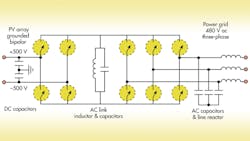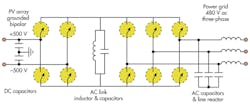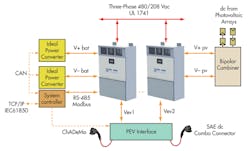Vehicle charging standards: A quick primer
As electric vehicles (EVs) proliferate, plugging in at home will remain the preferred means of vehicle charging. Apps on the vehicle owner’s mobile device must ensure that a) the vehicle is correctly plugged in; b) charging occurs only during off-peak periods to minimize costs; and c) the driver is directed to commercial charging stations when necessary to address range anxiety.
Related Articles
• Electric Vehicles Cruise Into The 2014 New York Auto Show
• Media Reports Fuel Unfounded Fears About EV Batteries
• Consumer Perception Inhibits Electric Vehicle Adoption
For home-based charging, the Society of Automotive Engineers (SAE) j1772 AC Level 2 charging standard has been adopted by both plug-in hybrid electric vehicles (PHEV), such as the Chevrolet Volt, and fully-electric plug-in vehicles (PEV), such as the Nissan Leaf. These charging systems support 3-7 kW of charge power by providing the AC to DC conversion in the vehicle, but still require 3.5 to 7 hours of charge time. (For more on international EV charging standards, see “Understanding U.S. And European Standards For Electric-Vehicle Charging.”)
For commercial charging stations, the vast majority deployed today are hardened/vandal-proof Level-2 ac systems, rated for a maximum of 6.6 kW), that are otherwise electrically identical to those found in the car owner’s garage. Commercial charging stations are key to addressing range anxiety. Establishing them on a broader scale is necessary and will also require a faster charging solution in order to further accelerate EV adoption.
This file type includes high resolution graphics and schematics when applicable.
The SAE has developed higher power dc Level-3 charging standards that use external ac to dc chargers that can handle up to 100 kW, with typical sizes of 25 to 50 kW.
A 50-kW external charging system would be capable of fully charging an EV in 20 minutes or less. For example, Nissan has installed dc fast chargers at many of its dealerships in North America. With this network in place, Nissan Leafs can be typically charged within 15 to 20 minutes. This represents an opportunity for Nissan to change the public dialogue by switching “range anxiety” to “range confidence” — one of the company’s new marketing taglines.
Today’s Fast-Charging Standards
Three fast-charging standards already exist. The CHAdeMO DC charging standard (used by Nissan, Mitsubishi, Toyota, and others) currently represents the largest fast-charging capable fleet in North America. The others are the SAE j1772 “Combo” (BMW, Ford, GM, et al.) and Tesla, which has its own Combo-based standard.
Dual-standard (CHAdeMO and SAE j1772) fast chargers do exist, although only a handful have been commercially deployed to date. Adding Tesla’s interface to these dual mode chargers appears straightforward because it is a derivative of the Combo standard.
As these multi-standard chargers proliferate, EV owners will confidently venture beyond the dealership-sponsored fast-charging networks they exclusively utilize today.
Barriers to Higher EV Fast-Charging Infrastructure
Nevertheless, all of these dc fast-charging standards do share a set of common challenges. They are expensive to deploy and operate due to demand charges (explained below). They also stress the host building’s electrical service and the local distribution grid.
The reason for that stress: When they are in service, at charge rates of 25, 50, and 75 or more kW, dc fast chargers could represent 25 percent or more of their host site’s total building load.
This is what leads to demand charges. These are additional charges, based on kW that electric utilities charge commercial customers (measured in kW) in addition to what they charge them for energy (measured in kWh). This is to help compensate for (and discourage) large intermittent fluctuations in demand.
Not only do fast chargers represent a new burdensome demand cost for hosts, installing them often dictates expensive ac-line upgrades in urban areas where facilities are already highly stressed. (Upgrades often include a larger service transformer, as well as heavier conduit and feeder circuit wiring).
This file type includes high resolution graphics and schematics when applicable.
On-Site Batteries and Other Mitigations
This file type includes high resolution graphics and schematics when applicable.
Utility demand charges are already proving to be excessive for rapid-charging installations. That’s why next-generation charging stations must incorporate local batteries. A large enough stationary battery incorporated into the dc fast-charging system can buffer the energy flow from the grid and thus lower-peak demand utility charges. A battery allows the EV charger to deliver higher power (faster charging) to the EV for short periods of time, and also to recharge from the grid comparatively slowly. Buffer batteries would be essential in enabling broader deployment of charging stations in urban areas where the cost of upgrading line service would be particularly prohibitive.
Also, along with batteries, adding photovoltaic (PV) carports into the mix would provide yet another source of demand mitigation, and would additionally create value-added vehicle-to-grid (V2G) capabilities. (However, managing PV’s variable output would also create a new set of control challenges.)
Putting it all Together
A major design challenge for any advanced EV-charging infrastructure will be to ensure that all these power sources are successfully integrated into the fast-charging framework. Not only must next-generation power converters be efficient and safe, but they must also accommodate the modularity and standardization necessary to tackle these challenges. This means advanced hardware and software design and an open set of communication protocols.
SunSpec Alliance
“Open” standards are crucial. Non-proprietary communication standards for energy storage devices are currently being developed by the SunSpec Alliance [www.sunspec.org] – a trade alliance of distributed energy industry participants, together pursuing standards to enable “plug-and-play” interoperability of components and systems that are compatible with diverse utility grids and micro-grids around the globe.
The SunSpec Alliance physical interface is Modbus 485, the same utilized by PV inverters, AC revenue meters, smart combiner boxes, environmental sensors, and data loggers sourced by other vendors. With this standard interface, a single daisy-chained cable easily interconnects the power conversion systems, sensors and power meters, simplifying the monitoring and control of these systems.
In addition to promoting open communication protocols, limiting vendor count and hardware platforms would simplify system integration, accelerate system development, and lower first and installed costs, as well as operating and maintenance costs.
Until recently, this wasn’t possible. No single vendor provided PV inverters, bi-directional battery converters, and EV fast chargers based on a common hardware, software, or communications platform. Without this common platform, each of the three power converters favored by the various car manufacturers would have to remain an island, requiring considerable system design and numerous data/protocol conversions to deliver an integrated charging that would rapidly and cheaply charge any EV that drives in.
Power Packet Switching Architecture
Recently, the first common hardware platform with an industry-standard communications and control interface that accommodates a PV inverter, a bi-directional energy storage buffer, and EV fast charging has become available. A key element is the Power Packet Switching Architecture (PPSA), an entirely new approach to electronic power converters (Fig. 1).
Related Articles
• Electric Vehicles Cruise Into The 2014 New York Auto Show
• Media Reports Fuel Unfounded Fears About EV Batteries
• Consumer Perception Inhibits Electric Vehicle Adoption
Because the input and output are never directly connected together, this current modulation technique provides circuit isolation without the size, weight, cost, and efficiency loss of a transformer. It also provides buck/boost voltage conversion, bi-directional power transfer, and multiport applications with any combination of independently controlled dc and dc power ports.
In a real-world implementation, the SAE j1772 combo-connector and CHAdeMO DC charger EV interfaces provide power connections to the vehicle, as well as communications and control (Fig. 2). The National Renewable Energy Laboratory (NREL) is cooperating with the industry on the development and demonstration of such solutions to support various EV charging scenarios.
John Merritt is director of applications engineering at Ideal Power. He has more than 30 years of technical marketing experience spanning product marketing, product development, engineering, and project management in both high-tech and cleantech companies. Prior to joining Ideal Power in early 2013, he spent three years at Draker/Solar Power Technologies working on both solar monitoring and solar power optimization technologies.
This file type includes high resolution graphics and schematics when applicable.



